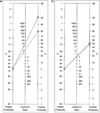Self-Selected Walking Speed is Predictive of Daily Ambulatory Activity in Older Adults
- PMID: 26371593
- PMCID: PMC4792803
- DOI: 10.1123/japa.2015-0104
Self-Selected Walking Speed is Predictive of Daily Ambulatory Activity in Older Adults
Abstract
Daily ambulatory activity is associated with health and functional status in older adults; however, assessment requires multiple days of activity monitoring. The objective of this study was to determine the relative capabilities of self-selected walking speed (SSWS), maximal walking speed (MWS), and walking speed reserve (WSR) to provide insight into daily ambulatory activity (steps per day) in community-dwelling older adults. Sixty-seven older adults completed testing and activity monitoring (age 80.39 [6.73] years). SSWS (R2 = .51), MWS (R2 = .35), and WSR calculated as a ratio (R2 = .06) were significant predictors of daily ambulatory activity in unadjusted linear regression. Cutpoints for participants achieving < 8,000 steps/day were identified for SSWS (≤ 0.97 m/s, 44.2% sensitivity, 95.7% specificity, 10.28 +LR, 0.58 -LR) and MWS (≤ 1.39 m/s, 60.5% sensitivity, 78.3% specificity, 2.79 +LR, 0.50 -LR). SSWS may be a feasible proxy for assessing and monitoring daily ambulatory activity in older adults.
Figures


References
-
- Barreira TV, Brouillette RM, Foil HC, Keller JN, Tudor-Locke C. Comparison of older adults’ steps per day using NL-1000 pedometer and two GT3X+ accelerometer filters. J Aging Phys Act. 2013;21(4):402–416. - PubMed
-
- Bohannon RW. Number of pedometer-assessed steps taken per day by adults: a descriptive meta-analysis. Phys Ther. 2007;87(12):1642–1650. - PubMed
-
- Bohannon RW, Williams Andrews A. Normal walking speed: a descriptive meta-analysis. Physiotherapy. 2011;97(3):182–189. - PubMed
-
- Boyer KA, Andriacchi TP, Beaupre GS. The role of physical activity in changes in walking mechanics with age. Gait Posture. 2012;36(1):149–153. - PubMed
Publication types
MeSH terms
Grants and funding
LinkOut - more resources
Full Text Sources
Other Literature Sources

